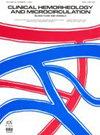超声波在颈动脉内膜切除术和颈动脉支架植入术围手术期的作用。
IF 2.1
4区 医学
Q3 HEMATOLOGY
引用次数: 0
摘要
背景本文回顾了超声技术在颈动脉内膜剥脱术和颈动脉支架植入术围手术期应用的最新研究成果,探讨了超声技术在准确评估颈动脉狭窄和斑块稳定性、协助选择最适合的手术方法以及提供最佳围手术期成像以指导颈动脉内膜剥脱术(CEA)和颈动脉支架植入术(CAS)以减少卒中发生和进展方面的作用。方法通过 CNKI、Pubmed 和 Web of Science 等数据库,对近年来发表的有关超声在 CEA 和 CAS 围手术期应用的研究进行回顾。结果超声在术前筛选适应症、评估颈动脉狭窄程度和斑块性质;术中监测血流动力学变化以防止脑缺血或过度灌注;术后和后期随访中评估手术效果等方面具有很高的临床价值。易损斑块的存在是缺血性脑卒中的重要危险因素。对比增强超声是评估斑块稳定性的绝佳工具。在大多数研究中,超声仅用于 CEA 和 CAS 术后的短期随访,需要更长时间的随访数据才能提供更可靠的证据。本文章由计算机程序翻译,如有差异,请以英文原文为准。
Utility of ultrasound in the perioperative phase of carotid endarterectomy and carotid artery stent implantation.
BACKGROUND
This article reviews the latest research results of the use of ultrasound technology in the perioperative period of carotid endarterectomy and carotid stenting and discusses the role of ultrasound technology in accurately evaluating carotid stenosis and plaque stability, assisting in selecting the most suitable surgical method, and providing optimal perioperative imaging to guide carotid endarterectomy (CEA) and carotid artery stenting (CAS) to reduce the occurrence and progression of stroke.
METHODS
The research published in recent years on the application of ultrasound in the perioperative period of CEA and CAS was reviewed through the databases of CNKI, Pubmed, and Web of Science.
RESULTS
Ultrasound has high clinical value in preoperative screening for indications, assessing the degree of carotid artery stenosis and the nature of plaque; monitoring hemodynamic changes intraoperatively to prevent cerebral ischemia or overperfusion; and evaluating surgical outcomes postoperatively and in late follow-up review.
CONCLUSION
Ultrasound is currently widely used perioperatively in CEA and CAS and has even become the preferred choice of clinicians to evaluate the efficacy of surgery and follow-up. The presence of vulnerable plaque is an important risk factor for ischemic stroke. Contrast-enhanced ultrasound is an excellent tool to assess plaque stability. In most studies, ultrasound has been used only in a short follow-up period after CEA and CAS, and data from longer follow-ups are needed to provide more reliable evidence.
求助全文
通过发布文献求助,成功后即可免费获取论文全文。
去求助
来源期刊
CiteScore
4.30
自引率
33.30%
发文量
170
期刊介绍:
Clinical Hemorheology and Microcirculation, a peer-reviewed international scientific journal, serves as an aid to understanding the flow properties of blood and the relationship to normal and abnormal physiology. The rapidly expanding science of hemorheology concerns blood, its components and the blood vessels with which blood interacts. It includes perihemorheology, i.e., the rheology of fluid and structures in the perivascular and interstitial spaces as well as the lymphatic system. The clinical aspects include pathogenesis, symptomatology and diagnostic methods, and the fields of prophylaxis and therapy in all branches of medicine and surgery, pharmacology and drug research.
The endeavour of the Editors-in-Chief and publishers of Clinical Hemorheology and Microcirculation is to bring together contributions from those working in various fields related to blood flow all over the world. The editors of Clinical Hemorheology and Microcirculation are from those countries in Europe, Asia, Australia and America where appreciable work in clinical hemorheology and microcirculation is being carried out. Each editor takes responsibility to decide on the acceptance of a manuscript. He is required to have the manuscript appraised by two referees and may be one of them himself. The executive editorial office, to which the manuscripts have been submitted, is responsible for rapid handling of the reviewing process.
Clinical Hemorheology and Microcirculation accepts original papers, brief communications, mini-reports and letters to the Editors-in-Chief. Review articles, providing general views and new insights into related subjects, are regularly invited by the Editors-in-Chief. Proceedings of international and national conferences on clinical hemorheology (in original form or as abstracts) complete the range of editorial features.

 求助内容:
求助内容: 应助结果提醒方式:
应助结果提醒方式:


